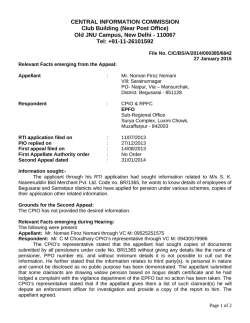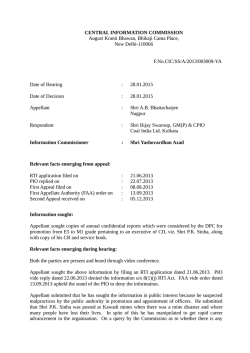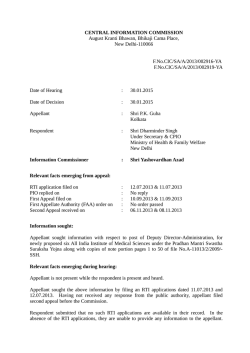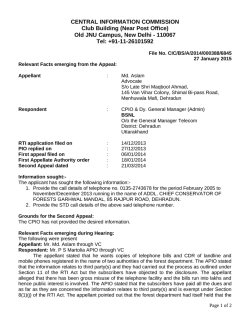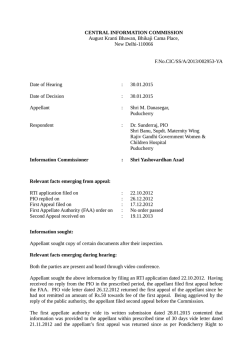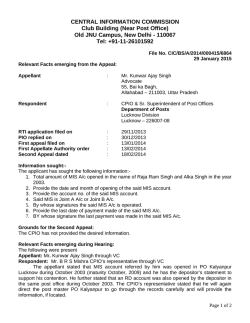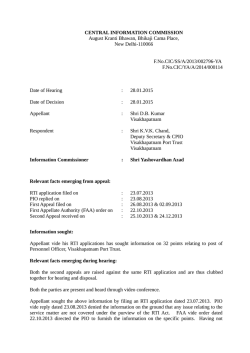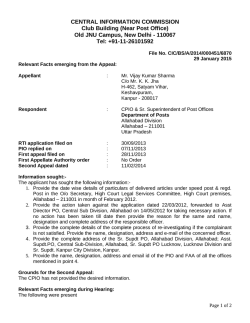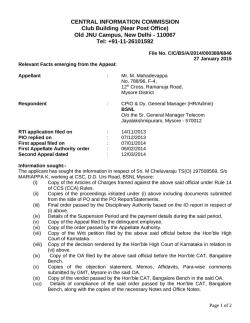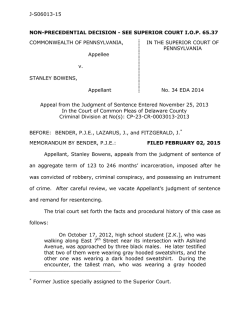
In the Supreme Court of Georgia Decided: February
In the Supreme Court of Georgia Decided: February 2, 2015 S14A1722. DEVAUGHN v. THE STATE. NAHMIAS, Justice. Appellant Jean Pierre DeVaughn was convicted of malice murder and other crimes in connection with the shooting death of William Eric Clark. On appeal, he argues that the trial court erred in striking two black jurors for cause, allowing a key witness to testify on short notice, and admitting evidence obtained in violation of his Miranda rights. Appellant also argues that the State failed to disclose an agreement with a witness. We affirm.1 1 The victim was killed on December 13, 2005. On May 29, 2009, after the police had reinitiated the investigation as a “cold case” in 2008, a Fulton County grand jury indicted Appellant, Constance Clark, and Christopher Tumlin for malice murder, two counts of felony murder, aggravated assault with a deadly weapon, hijacking a motor vehicle, and possession of a firearm during the commission of a crime; Appellant and Clark were also charged with conspiracy to commit murder. Appellant was tried separately from April 4 to 11, 2011, and the jury found him guilty of all charges. The trial court sentenced Appellant to life in prison for malice murder and consecutive terms of 20 years for the hijacking conviction and five years for the firearm conviction. The felony murder verdicts were vacated by operation of law, and the aggravated assault and conspiracy counts merged. Appellant filed a timely motion for new trial, which he amended with the assistance of new counsel on September 12, 2011. After a hearing, the trial court denied the motion on May 3, 2013. Appellant filed a timely notice of appeal, and the case was docketed in this Court for the September 2014 term and submitted for decision on the briefs. Clark was convicted in her separate trial on all charges except hijacking and felony murder predicated on hijacking; her appeal to this Court is pending decision in Case No. S14A1685. Tumlin testified at Appellant’s trial under a grant of use immunity; the record does not indicate how the 1. Viewed in the light most favorable to the verdicts, the evidence at trial showed the following. Appellant’s cousin, Constance Clark (Clark), was the victim’s wife; the couple lived in Bessemer, Alabama. Clark was having financial difficulties, and the victim had life insurance policies for $600,000 that named her as the primary beneficiary. Clark told Appellant that the victim abused her and offered Appellant $5,000 to kill him. The victim worked a side job as a bartender, and on December 13, 2005, he drove from his home to Atlanta to meet with Appellant, who was supposed to take him to a discount liquor store to purchase supplies for an event. Appellant called his friend Khorey Branch to ask if Branch knew where he could buy a gun, and Branch contacted Christopher Tumlin, who agreed to sell Appellant a handgun. Appellant and Branch drove in Appellant’s car to Tumlin’s home in southwest Atlanta, where Tumlin sold Appellant a handgun. Tumlin then rode with Appellant and Branch to a gas station near Six Flags, where they met up with the victim around 9:00 p.m. Under the impression that he was being led to the liquor store, the victim charges against him were resolved. The record does not indicate whether Khorey Branch, who was with Appellant and Tumlin at the time of the crimes, was ever charged. 2 followed Appellant and his two associates until both cars stopped in a driveway in an isolated section of the unfinished Waterford Edge subdivision near College Park. Appellant and the victim got out of their cars and engaged in what appeared to be a casual conversation until Appellant suddenly pulled out his gun and shot the victim four or five times, killing him. Immediately after the shooting, Tumlin jumped out of Appellant’s car and got into the victim’s car, and both cars sped out of the subdivision. Appellant dropped Branch off at Branch’s home before returning home himself. Appellant called the victim’s cell phone, which Tumlin answered, to ask where Tumlin planned to leave the victim’s car; Tumlin told Appellant not to call him and then abandoned the victim’s car about a mile from his home. After returning home, Tumlin received a call on his own cell phone from Appellant, who warned that Tumlin or his parents might get hurt if he told the police about the shooting. Branch and Tumlin testified at Appellant’s trial. Two residents who lived in the completed part of Waterford Edge testified to hearing shots fired, seeing the victim’s body in a driveway, and watching two cars – one of which matched the description of Appellant’s car – drive out of the subdivision with their headlights off. Another witness, who had dated Clark for a year starting a few 3 months after the victim’s death, told the police that Clark had paid her cousin $5,000 to kill the victim. Appellant’s former manager at a lumber company testified that in 2005, Appellant delivered materials to the Waterford Edge subdivision. Appellant’s cell phone records indicated that on the night of the shooting, he traveled from his home toward Tumlin’s house, then to the area of the crime scene, and then back to his home. The cell phone records also showed calls from Appellant to Clark shortly before and after the shooting. The evidence presented at trial and summarized above was sufficient to authorize a rational jury to find Appellant guilty beyond a reasonable doubt of the crimes for which he was convicted. See Jackson v. Virginia, 443 U.S. 307, 319 (99 SCt 2781, 61 LE2d 560) (1979). See also Vega v. State, 285 Ga. 32, 33 (673 SE2d 223) (2009) (“‘It was for the jury to determine the credibility of the witnesses and to resolve any conflicts or inconsistencies in the evidence.’” (citation omitted)). 2. Appellant argues first that the jury selection process was tainted by racial bias. He failed, however, to raise this issue at trial, and he therefore did not preserve it for review on appeal. See Higuera-Hernandez v. State, 289 Ga. 553, 554 (714 SE2d 236) (2011). In any event, the claim is meritless. 4 Pointing to the trial court’s removal for cause of two African-American potential jurors, Jurors 13 and 42, Appellant asserts that the jury selection process was unconstitutional under Batson v. Kentucky, 476 U.S. 79 (106 SCt 1712, 90 LE2d 69) (1986). However, “[t]he analysis of Batson applies only to the use of peremptory strikes, and we are unaware of any authority for extrapolating the Batson framework to for-cause strikes.” Head v. State, 276 Ga. 131, 134 (575 SE2d 883) (2003) (footnote omitted). See also Batson, 476 U.S. at 82 (introducing the case as involving “the evidentiary burden placed on a criminal defendant who claims that he has been denied equal protection through the State’s use of peremptory challenges to exclude members of his race from the petit jury”). Of course, racial bias is an impermissible basis for striking jurors for cause, see id. at 84, but Appellant has not shown that Jurors 13 and 42 were struck on the basis of their race. During voir dire, Juror 13 said that his prior bad experiences with the police and prosecutors might affect his judgment in the case and that he was a minister and would not feel comfortable sitting in judgment of others. Juror 42 twice broke down crying in the courtroom when questioned about her brother, who had recently died in prison, and said that her brother had been represented 5 by an incompetent attorney when he was convicted for murder. The trial court has broad discretion to determine a potential juror’s impartiality and to strike for cause jurors who may not be fair and impartial. See Robles v. State, 277 Ga. 415 415, 419-420 (589 SE2d 566) (2003) (finding no abuse of discretion where trial court struck for cause one prospective juror who said she would not stand in judgment of another, a second who stated he did not believe the law was applied evenly, and a third who said she could not stand in judgment of another because of her religious beliefs and would not look at certain graphic evidence); Pruitt v. State, 270 Ga. 745, 751 (514 SE2d 639) (1999) (finding no abuse of discretion where trial court excused for cause a juror who stated that the legal system was unfair because he believed his brother had been convicted in an unfair trial). We see no abuse of discretion here and, more importantly, no indication that the trial court struck Jurors 13 and 42 because of their race. 3. Appellant next enumerates as error that his right to confront witness Khorey Branch was violated. Appellant did not make a Confrontation Clause objection at trial, and he therefore failed to preserve such an issue for review. See Higuera-Hernandez, 289 Ga. at 554. Moreover, any such objection would have been frivolous, because Branch testified at trial and Appellant had the 6 opportunity to cross-examine him, so Appellant’s right to confront Branch was fully satisfied. See Crawford v. Washington, 541 U.S. 36, 59 & n.9 (124 SCt 1354, 158 LE2d 177) (2004). Looking to the argument made in support of this enumeration, Appellant’s real complaint is that the State violated a criminal discovery statute by not informing the defense that Branch would testify until the first day of trial. OCGA § 17-16-8 (a) requires the prosecutor to disclose to defense counsel the names of and other information about the State’s witnesses not later than ten days before trial . . . or as otherwise ordered by the court, . . . unless for good cause the judge allows an exception to this requirement, in which event [defense] counsel shall be afforded an opportunity to interview such witnesses prior to the witnesses being called to testify. Here, the prosecutor explained to the trial court that Tumlin had told investigators that a person known as “Khorey” had watched Appellant shoot the victim, but claimed not to know Khorey’s last name.2 Tumlin identified another person who would know how to contact Khorey, but despite an exhaustive search, the State was not able to locate that person until the Friday night before 2 Tumlin’s statement regarding Khorey was provided to the defense in timely discovery. 7 trial, and that person refused to speak with an investigator until the following Monday morning. On that morning – the morning the trial began – the contact person provided the State with a last name and phone number for Khorey. The investigator was able to identify and speak with Khorey Branch for the first time as the jury was being selected. Under these circumstances, the trial court did not abuse its discretion in ruling that the State had established good cause for allowing an exception to the ten-day rule. See Puga-Cerantes v. State, 281 Ga. 78, 80 (635 SE2d 118) (2006) (finding that good cause was shown where a witness fled prior to trial and was not located again until the first day of trial). The court complied with § 17-168 (a) by granting the defense a continuance until noon the following day to interview Branch and review his statement to the investigators; Appellant was also excused from the requirement of obtaining certified copies of Branch’s prior convictions for impeachment. Appellant says that he was prejudiced by the brevity of the continuance granted, but “[m]ere shortness of time . . . does not ipso facto show a denial of the rights of an accused.” Livingston v. State, 266 Ga. 501, 503 (467 SE2d 886) (1996). See also Wilkins v. State, 291 Ga. 483, 487 (731 SE2d 346) (2012) (finding no abuse of discretion in allowing a 8 witness to testify despite his not being on the State’s witness list where the court “suspended trial overnight to afford appellant to interview the witness . . . and review notes related to the content of his interview by police”). Appellant speculates that with a week-long continuance he might have been able to show that Branch’s testimony was concocted by investigators, but Appellant offered no evidence at the motion for new trial hearing – held more than two years after trial – to support that speculation. Moreover, Appellant was able to effectively cross-examine Branch and impeach him using his prior statement to the investigators. See Norris v. State, 289 Ga. 154, 156-157 (709 SE2d 792) (2011) (finding no abuse of discretion where the trial court gave the defendant an opportunity to interview the witnesses and the defendant impeached the most important witness with a prior inconsistent statement). 4. Appellant claims that his cell phone number and the cell phone records obtained using that number should have been suppressed because he was not given Miranda warnings before he told investigators his number. See Miranda v. Arizona, 384 U.S. 436 (86 SCt 1602, 16 LE2d 694) (1966). See also Wong Sun v. United States, 371 U.S. 471, 484 (83 SCt 407, 9 LE2d 441) (1963) (holding that evidence acquired as the “fruit” of unlawful police action should 9 be suppressed). We disagree. “Miranda warnings are required when a person ‘is (1) formally arrested or (2) restrained to the degree associated with a formal arrest.’ Unless a reasonable person would perceive that he is in custody, Miranda warnings are not necessary.” Freeman v. State, 295 Ga. 820, 822-823 (764 SE2d 390) (2014) (citations omitted). The record in this case supports the trial court’s findings that Appellant drove himself to the police station after being asked to speak to the investigators; while the police temporarily took his car keys so that they could inspect the car in his presence, he was not restrained in any way, was never told he was under arrest, and was allowed to speak to his mother on the phone during the interview; and, when he asked to leave, he was allowed to do so. See id. at 823 (“On appeal, the issue is whether the trial court was clearly erroneous in its factual findings regarding the admissibility of the statements.” (citation omitted)). Accordingly, the trial court correctly determined that Appellant was not in custody during the interview and thus not entitled to Miranda warnings. See Teasley v. State, 293 Ga. 758, 762 (749 SE2d 710) (2013) (holding that a defendant was not in custody when he went to the police station on his own accord and was not restrained in any way); Hightower v. 10 State, 272 Ga. 42, 43 (526 SE2d 836) (2000) (finding that a defendant was not in custody where he voluntarily submitted to an interview at a police station, cooperated fully in answering questions, was not restrained, and presented no evidence that officers had placed any limits on his freedom to leave or to terminate questioning).3 Appellant also contends that his cell phone number and related cell phone records should have been suppressed because the police continued to question him after he requested an attorney. See Jordan v. State, 267 Ga. 442, 444 (480 SE2d 18) (1997) (“Law enforcement officers must immediately cease questioning a suspect who has clearly asserted a right to have counsel present during custodial interrogation.” (emphasis in original)). The trial court suppressed all of Appellant’s statements made after the point at which he arguably requested counsel. The record shows, however, that Appellant 3 Appellant claims, but the State denies, that the police considered him a suspect from the moment he walked into the police station. Regardless, courts determine whether a person is in custody based upon the totality of the circumstances; Miranda warnings are not required simply because questioning takes place in a police station or because the person being questioned is considered a suspect by the police. See California v. Beheler, 463 U.S. 1121, 1125 (103 SCt 3517, 77 LE2d 1275) (1983). In fact, when it is undisclosed to the interviewee, “a police officer’s subjective view that the individual under questioning is a suspect . . . does not bear upon the question whether the individual is in custody for purposes of Miranda.” Stansbury v. California, 511 U.S. 318, 324 (114 SCt 1526, 128 LE2d 293) (1994). 11 disclosed his cell phone number long before mentioning a lawyer, so the phonerelated evidence was also not suppressible on this ground. 5. Finally, Appellant argues that his convictions should be reversed because the State made an undisclosed immunity or leniency deal with Branch in exchange for his testimony against Appellant, in violation of Giglio v. United States, 405 U.S. 150 (92 SCt 763, 31 LE2d 104) (1972). Appellant asserts that there must have been such a deal in place at trial because no charges have been filed against Branch in connection with the victim’s murder even though Branch supposedly implicated himself through his testimony. However, “‘[t]he subsequent disposition of charges against the [witness], standing alone, does not establish the existence of a deal.’” Wimes v. State, 293 Ga. 361, 363 (744 SE2d 787) (2013) (citation omitted). The State denied the existence of a deal at the motion for new trial hearing, the trial court credited that representation, and in the absence of anything but speculation to the contrary, we cannot say that the court’s finding that there was no deal with Branch is clearly erroneous. See id. Judgment affirmed. All the Justices concur. 12
© Copyright 2024
